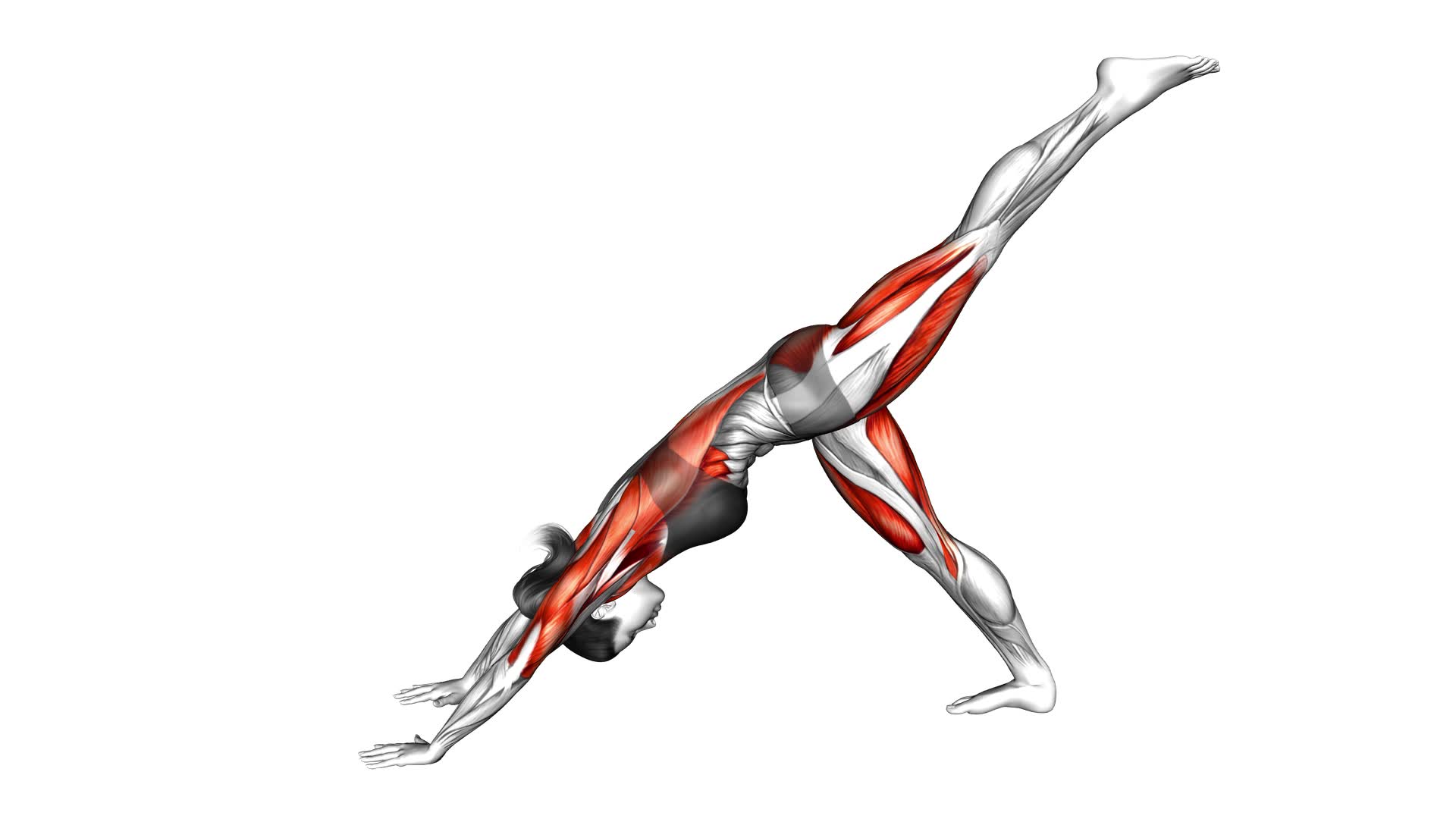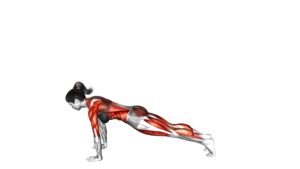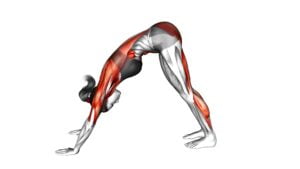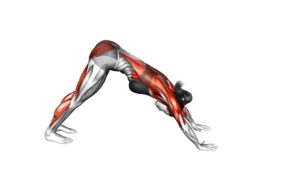3 Leg Dog Pose (female) – Video Exercise Guide & Tips

Get ready to strengthen your core and improve your balance with the 3 Leg Dog Pose. This video exercise guide and tips will help you master this pose and incorporate it into your yoga routine.
Watch This Exercise Video
Whether you're a beginner or an experienced yogi, this pose offers a range of modifications and variations to suit your skill level. Say goodbye to common mistakes and hello to a stronger practice.
Let's dive in and discover the benefits of the 3 Leg Dog Pose.
Key Takeaways
- The 3 Leg Dog Pose strengthens core muscles and targets muscles in the arms, shoulders, and legs.
- It improves flexibility in the hamstrings and calves and enhances balance and proprioception.
- Modifications and variations can be made to accommodate injuries or physical limitations and to increase the stretch.
- Common mistakes to avoid include allowing hips to sink too low, collapsing and rounding shoulders, and holding breath or shallow breathing.
Benefits of the 3 Leg Dog Pose
Experience the numerous benefits of the 3 Leg Dog Pose as you strengthen your core, improve flexibility, and enhance your overall balance. This yoga pose is a variation of the traditional Downward Facing Dog, but with the added challenge of lifting one leg off the ground. By engaging your core muscles, the 3 Leg Dog Pose helps to build a strong and stable center. It also targets the muscles in your arms, shoulders, and legs, making it a great full-body exercise.
One of the main benefits of the 3 Leg Dog Pose is that it helps to improve flexibility. As you lift your leg, you're stretching the muscles in your hamstrings and calves, increasing their range of motion. This can be especially beneficial for athletes or anyone looking to improve their overall flexibility.
Additionally, the 3 Leg Dog Pose helps to enhance your balance. By balancing on three limbs instead of four, you're challenging your stability and proprioception. This can be particularly helpful for individuals who struggle with balance or are looking to improve their coordination.
To modify the pose, you can use a yoga block or a folded blanket under your hands for added support. This can help to alleviate any strain in your wrists or shoulders. You can also try bending your lifted leg slightly or placing it on a wall for extra stability.
Incorporating the 3 Leg Dog Pose into your yoga practice can provide you with a wide range of benefits, from strengthening your core and improving flexibility to enhancing your overall balance. Experiment with modifications to find the version that works best for you and enjoy the rewards of this empowering pose.
Preparing for the 3 Leg Dog Pose
To prepare for the 3 Leg Dog Pose, start by getting into the traditional Downward Facing Dog position. This foundational pose will help you build strength and flexibility in your arms, shoulders, and hamstrings, making it easier for you to transition into the 3 Leg Dog Pose.
Here are some preparing techniques and benefits of modifications to keep in mind:
- Warm up your body: Before attempting any challenging pose, it's important to warm up your muscles and joints. Start with a few rounds of Sun Salutations or any other gentle flow to get your blood flowing and your body ready for the pose.
- Engage your core: To maintain stability and control throughout the pose, engage your core muscles. This will help you maintain balance and prevent strain on your lower back.
- Modify as needed: If you're struggling to lift one leg off the ground, you can use a block or a wall for support. Place your hands on the block or walk your feet up the wall to make it easier to balance and lift your leg.
By incorporating these preparing techniques and modifications, you can gradually build your strength and flexibility, making it easier to master the 3 Leg Dog Pose.
Now, let's dive into the step-by-step guide to mastering the pose.
Step-By-Step Guide to Mastering the Pose
To begin mastering the 3 Leg Dog Pose, follow these step-by-step instructions. Start in a tabletop position on your hands and knees. Ensure your hands are directly under your shoulders and your knees are under your hips. Spread your fingers wide and press firmly into your palms. Tuck your toes and lift your hips up towards the ceiling, coming into an inverted V shape. Keep your arms straight and your legs hip-width apart.
Next, shift your weight onto your left leg and lift your right leg up towards the ceiling. Keep your hips square and your toes pointed. Engage your core to maintain balance. Hold this position for a few breaths, focusing on improving your balance and flexibility.
Lower your right leg back down and repeat the same steps with your left leg. Remember to keep your movements controlled and fluid. As you continue practicing, you'll gradually build strength and stability in your upper body and improve your overall balance and flexibility.
Now, let's move on to modifications and variations for different skill levels, where you can further challenge yourself or adapt the pose to your needs.
Modifications and Variations for Different Skill Levels
As you progress in your mastery of the 3 Leg Dog Pose, you can explore modifications and variations to challenge yourself and tailor the pose to your specific skill level.
Here are some modifications and variations to consider:
- Modifications for injuries: If you have any injuries or physical limitations, it's important to modify the pose to avoid further harm. For example, if you have wrist pain, you can place your forearms on the mat instead of your hands. If you have knee issues, you can use a blanket or a block to support your knees. Remember to listen to your body and only go as far as feels comfortable.
- Variations for flexibility: If you're looking to improve your flexibility, there are several variations you can try. One option is to lift one leg higher in the air, reaching towards the ceiling. This will increase the stretch in your hamstrings and calves. Another variation is to bend one knee and bring it towards your chest, creating a deeper stretch in your hip flexors. You can also experiment with different arm positions, such as reaching one arm towards the front of the mat or twisting the torso to the side.
Remember to always warm up before attempting any modifications or variations, and if you're unsure about a specific modification, consult with a qualified yoga instructor.
Common Mistakes to Avoid While Practicing the Pose
To avoid common mistakes while practicing the Leg Dog Pose, make sure to maintain proper alignment and engage the correct muscles throughout the exercise. One common mistake is letting your hips sink too low, causing your lower back to arch excessively. This can put strain on your back and decrease the effectiveness of the pose. To avoid this mistake, focus on keeping your core engaged and your hips lifted, creating a straight line from your head to your tailbone.
Another mistake is allowing your shoulders to collapse and round forward. This can strain your neck and shoulders and limit the benefits of the pose. Instead, actively press your hands into the ground and broaden your shoulder blades, creating space and stability in your upper body.
Lastly, be mindful of your breath. Holding your breath or shallow breathing can hinder the flow of energy and relaxation in the pose. Remember to breathe deeply and fully throughout the exercise, allowing your breath to guide and support your movements.
Tips for Incorporating the 3 Leg Dog Pose Into Your Yoga Routine
To get the most out of incorporating the 3 Leg Dog Pose into your yoga routine, it's important to understand the benefits, modifications, and variations.
This pose helps to strengthen your upper body and core, improve balance, and stretch your hamstrings and calves.
If you're a beginner, you can start by using a block or wall for support, and gradually work your way up to lifting your leg higher.
For advanced practitioners, you can challenge yourself by adding in variations like twisting or transitioning into other poses.
Benefits of 3-Leg Dog
To experience the benefits of the 3-Leg Dog pose and incorporate it into your yoga routine, start by bringing your attention to the alignment of your body. Proper alignment is crucial for maximizing the benefits and preventing injuries.
Here are three benefits of the 3-Leg Dog pose and tips for incorporating it into your practice:
- Flexibility: This pose helps to stretch and lengthen your hamstrings, calves, and hip flexors. It improves flexibility in your lower body, making it easier to perform other yoga poses.
- Balance: The 3-Leg Dog pose challenges your balance and stability. By lifting one leg off the ground, you engage your core muscles and improve your overall balance.
- Modifications for injuries: If you have wrist or shoulder injuries, you can perform this pose with the support of props like blocks or blankets. This modification reduces the strain on your wrists and shoulders while still reaping the benefits of the pose.
Incorporating the 3-Leg Dog pose into your yoga routine can enhance your flexibility, balance, and overall well-being. Remember to listen to your body and make modifications as needed.
Modifications for Beginners
To modify the 3-Leg Dog pose for beginners, use a yoga strap or a block to assist with balance and support. These props can be incredibly helpful in maintaining stability and preventing strain on the wrists.
Start by placing the yoga strap around your upper arms, just above the elbows. This will provide a physical reminder to keep your arms shoulder-width apart. As you progress, you can gradually move the strap down to your forearms, and eventually remove it altogether.
Alternatively, you can use a block under your hands to elevate the floor and reduce the intensity of the pose. Remember to listen to your body and only go as far as feels comfortable.
With consistent practice, you'll gradually build strength and flexibility in your shoulders, core, and legs.
Variations for Advanced Practitioners
As an advanced practitioner, incorporate the 3-Leg Dog Pose into your yoga routine by exploring various variations that challenge your strength and flexibility while building upon the modifications discussed earlier.
Here are three advanced techniques to try:
- Extended Leg Variation: From the 3-Leg Dog Pose, extend your lifted leg straight out behind you, parallel to the floor. This variation increases the demand on your core and hip flexors, intensifying the stretch in your hamstrings.
- Twisted Leg Variation: As you lift one leg in the 3-Leg Dog Pose, rotate your torso towards the opposite side, reaching the lifted leg underneath your body. This advanced modification adds a spinal twist, engaging your obliques and improving spinal mobility.
- One-Arm Variation: Challenge your upper body strength by lifting one arm off the mat while maintaining the 3-Leg Dog Pose. This advanced modification engages your core and stabilizing muscles, enhancing overall body control and balance.
Incorporate these advanced modifications into your practice to take your 3-Leg Dog Pose to the next level, deepening your practice and reaping the benefits of increased strength and flexibility.
Frequently Asked Questions
What Are the Benefits of the 3 Leg Dog Pose for Pregnant Women?
During pregnancy, it's important to maintain proper alignment in the 3 leg dog pose. This pose can help strengthen the core, improve balance, and relieve back pain.
To ensure safety, pregnant women can modify the pose by keeping a wider stance, using a wall for support, or using a chair for balance. Variations like the supported 3 leg dog pose can also be beneficial.
Remember to listen to your body and consult with your healthcare provider before practicing any new exercise during pregnancy.
Can the 3 Leg Dog Pose Help With Lower Back Pain?
Yes, the 3 leg dog pose can help with lower back pain. By stretching and strengthening your back muscles, this yoga pose can provide relief and improve flexibility.
However, if you're pregnant, it's important to modify the pose to ensure safety. Alternatives for pregnant women include cat-cow pose or child's pose.
Remember to listen to your body and consult with a yoga instructor for proper guidance.
Is It Safe to Practice the 3 Leg Dog Pose if You Have Wrist or Shoulder Injuries?
If you have wrist or shoulder injuries, practicing the 3 leg dog pose may not be safe. It's important to modify the pose to protect your wrists. Instead, focus on wrist modifications like doing the pose on your forearms or using yoga blocks for support.
For shoulder injuries, try alternative poses like downward facing dog or child's pose, which put less strain on the shoulders.
Always listen to your body and consult with a professional if needed.
How Long Should I Hold the 3 Leg Dog Pose for Maximum Benefits?
To get the maximum benefits from the 3 leg dog pose, it's important to hold it for the right amount of time. Beginners can start with holding it for 10-15 seconds and gradually increase the duration as they get more comfortable.
For advanced practitioners, variations of the pose can be incorporated to challenge the body further. Remember to listen to your body and modify the pose if you have any wrist or shoulder injuries.
Can the 3 Leg Dog Pose Help Improve Balance and Stability?
The 3 leg dog pose can definitely help improve your balance and stability. By engaging your core muscles and focusing on your alignment, this pose challenges your body to maintain stability.
As you practice this pose regularly, you'll notice an improvement in your coordination and overall balance. It's a great way to enhance your core strength and stability while also toning your legs and glutes.
Conclusion
Incorporating the 3 Leg Dog Pose into your yoga routine can offer numerous benefits for your mind and body. By following the step-by-step guide and incorporating modifications to suit your skill level, you can master this pose and reap its rewards.
Avoid common mistakes and practice regularly to improve your balance, flexibility, and strength.
So, why wait? Start incorporating the 3 Leg Dog Pose into your yoga practice today and elevate your fitness journey to new heights.

Author
Years ago, the spark of my life’s passion ignited in my mind the moment I stepped into the local gym for the first time. The inaugural bead of perspiration, the initial endeavor, the very first surge of endorphins, and a sense of pride that washed over me post-workout marked the beginning of my deep-seated interest in strength sports, fitness, and sports nutrition. This very curiosity blossomed rapidly into a profound fascination, propelling me to earn a Master’s degree in Physical Education from the Academy of Physical Education in Krakow, followed by a Sports Manager diploma from the Jagiellonian University. My journey of growth led me to gain more specialized qualifications, such as being a certified personal trainer with a focus on sports dietetics, a lifeguard, and an instructor for wellness and corrective gymnastics. Theoretical knowledge paired seamlessly with practical experience, reinforcing my belief that the transformation of individuals under my guidance was also a reflection of my personal growth. This belief holds true even today. Each day, I strive to push the boundaries and explore new realms. These realms gently elevate me to greater heights. The unique combination of passion for my field and the continuous quest for growth fuels my drive to break new ground.







